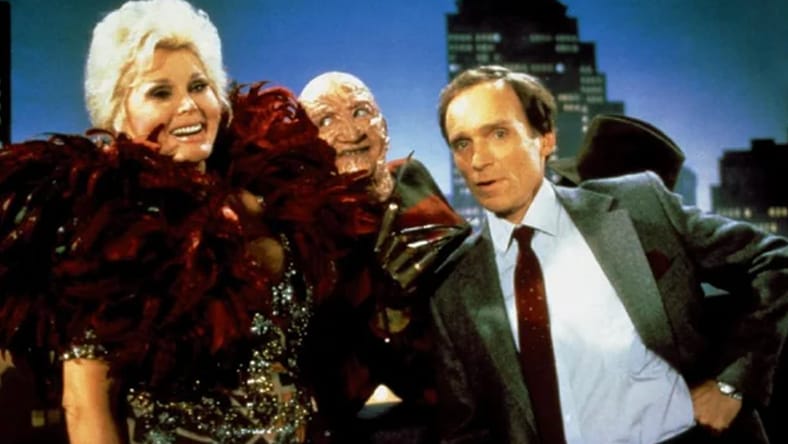Welcome to Prime Time!: How ‘A Nightmare on Elm Street’ Nabbed a Talk Show Legend

One of this year’s most anticipated horror releases is the upcoming Late Night with the Devil, starring David Dastmalchian (The Suicide Squad) as a talk show host whose Late Night program is plagued by supernatural forces. Releasing on March 22nd, the found-footage period piece is fusing two seemingly incongruent formats: the paranormal thriller and the Late Night Talk Show.
That’s at first glance. Actually, these media spaces have an interesting history of embracing each other. The first interaction between the two which probably comes to mind is when Arsenio Hall “interviewed” Jason Voorhees (played by Kane Hodder) for Jason Takes Manhattan. It’s safe to say that this interview, in which Arsenio chums it up with a mute Jason, is more fondly remembered than the movie they were there to promote.
Years before that moment of pop-culture bliss, the producers of A Nightmare on Elm Street III: Dream Warriors nabbed a cameo that retrospectively looks like a subtle watershed moment for slasher cinema’s relevance to mainstream culture.
For the nightmare sequence where Freddy Kruger kills an aspiring actress after disguising himself as a Talk Show Host, the filmmakers decided to cast an actual host in the small but memorable role. Who would they get to partake in this meta-gag? David Letterman? Nah. Johnny Carson? Nope.
Also Read: Bloody Mary: 10 Jenna Ortega Roles to Prove She Is Horror’s Reigning Queen
Enter Dick Cavett, a venerated interviewer who’d made a career out of chatting with public figures ranging from politicians, writers, journalists, and yes, directors. One of his most famous interviews was with Alfred Hitchcock, where the legendary director clarified that he never said that “actors are cattle,” but rather that “actors should be treated as cattle.” Among the other directors that Cavett interviewed were Martin Scorsese, Brian De Palma, Spike Lee, and Orson Welles, just to name a few.
Having a background in stand-up comedy, Cavett had a natural wit and carried himself with humor, but his program had also been a platform for serious discourse that covered important topics. It was also a space that could lead to tense arguments and confrontations between guests. One particularly shocking moment was when Cavett interviewed Georgia Governor and rabid segregationist Lester Maddox. An eccentric and flamboyant character, Lester Maddox was like something of a White Nationalist Truman Capote. After a defensive exchange with fellow guest Jim Brown, Maddox actually walked off the show after Cavett challenged him further.
In short, Cavett was no lightweight. He was a widely respected journalist who interviewed some of the 20th century’s most notable figures. So it’s actually quite stunning that Cavett would sign up for a Nightmare on Elm Street sequel at a time when the slasher genre, and horror in general, was being culturally marginalized as sleazy exploitation. This is only years after Gene Siskel tried doxxing Betsy Palmer because he was so offended at her participation in the original Friday the 13th.
Also Read: Sidney Prescott is the Best Final Girl
Though securing Dick Cavett’s involvement wasn’t difficult, he did have a request. While the original script had Dick Cavett/Freddy Krueger interviewing Sally Kellerman, an actress popular for starring in M.A.S.H and Brewster McCloud, Cavett asked that he get to choose his “dream” guest.
The guest he chose to skewer was fashion model Zsa Zsa Gabor, whom Cavett referred to as “the dumbest person [he’d] ever met.” So maybe Cavett wasn’t really acting when he interrupted Zsa Zsa’s banal answer by pulling out the Freddy glove and shouting, “Who gives a fuck what you think?!”
Of course, this is the moment before Freddy’s head emerges from the television set and he delivers one of his most beloved one-liners: “Welcome to Prime Time, Bitch.” Cavett’s cameo is etched into horror history for that moment alone.
While Cavett’s cameo in A Nightmare on Elm Street III: Dream Warriors is a cute gag that sets up an iconic line, it symbolized a breakthrough for the slasher genre as it emerged from its underground status to plant itself as a bustling industry that raised profit margins at unparalleled rates. Cavett’s cameo was the establishment’s first open acknowledgment of slasher cinema. Aresnio’s interview was the coronation.
Also Read: Nancy Thompson Is the Ultimate Final Girl
That begs the question: why do we love to see late-night hosts grace us horror fans with their presence? Why do we care what they think, or what they endorse? It’s not like we turn to Jimmy Fallon for movie recommendations. We don’t feel the need to watch something just because James Corden plugged it.
It’s easy to think of talk show hosts as the middlemen of entertainment. They throw softball questions at their celebrity guests who likely don’t want to be there but are contractually obligated to plug their new movie, or show, or book, or podcast, or whatever else they can sell to us. Being a talk show host isn’t the most prestigious occupation in the business, especially after the days of Dick Cavett when the talk show format disincentivizes nuanced or productive conversations to prioritize viral moments and useful soundbites.
That’s the thing, though. Their deliberately wide appeal and coveted platform make them arbiters of popular culture. Whether we like it or not, they personify mainstream interests and appeals. So when they acknowledge a new burgeoning genre like slasher movies, it’s not just cute: it’s a direct signifier of widening reach.
That’s easy to take for granted in an age when A-listers are leading horror movies and get to joke about their experiences with Jimmy Kimmel, but back then there just wasn’t that embrace of the genre.
In just a 10-second gag, Dick Cavett signaled that the cultural appeal of the slashers was undeniable. In other words, he welcomed them to Prime Time.
Categorized:Editorials

